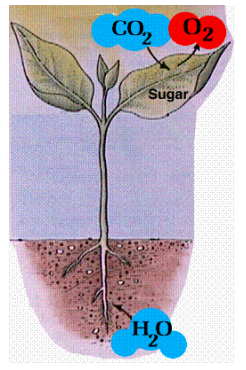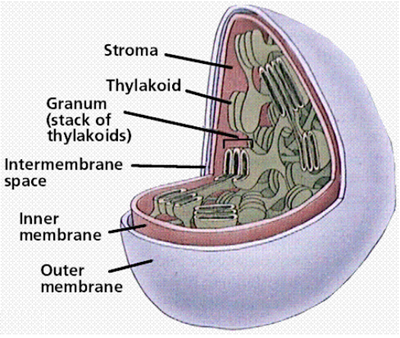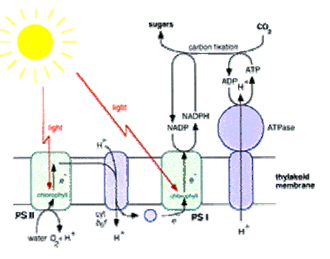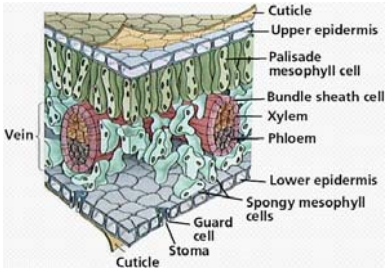Click here to view a video that explains photosynthesis.
Photosynthesis The primary source of energy for all living organisms on earth is the sun, 150 million kilometres from earth. Energy is generated from light and heat. Heat energy cannot be captured directly by either plants or animals, but light energy is captured by green plants. It is this captured energy that is used by animals via plants, to meet all their needs. To obtain this energy, an animal requires food from plants, which can be broken down in the animal's body to provide the necessary energy for the animal's life processes. Only plants can however capture light energy directly and they do this through the process of photosynthesis.
Photosynthesis is the process through which plants trap light energy and converts it into chemical energy which is then released by means of respiration. Life on earth, as we know, cannot exist without the process of photosynthesis.
During photosynthesis, plants convert light energy into stored energy. Plants thus have the ability to manufacture their own food. Photosynthesis is possible because plants have an energy-capturing green pigment substance called chlorophyll, which also gives plants their green colour. Photosynthesis also occurs in seaweed and other algae, mosses and not only in vascular plants.
A plant’s chlorophyll captures the light energy and uses it to manufacture carbohydrates from the raw materials water (hydrogen and oxygen), carbon dioxide (carbon and oxygen). These raw materials are sourced through the plant’s roots and leaves. Water, containing minerals, enters the plants through the roots and is channelled up the stem and into the veins of the leaves in the vascular system, and the carbon dioxide enters the left through the stomata.

Figure 4.1: Diagram indicating the transport of water through the plant.
Photosynthesis has as its final product carbohydrates. Carbohydrates are compounds composed of carbon, hydrogen and oxygen atoms such as sugar, glucose and fructose (simple carbohydrates). Starch and cellulose are also carbohydrates, but these are complex carbohydrates. A simple carbohydrate is made up of a few carbon, hydrogen and oxygen atoms while complex carbohydrates are made up of many of each of the three basic atoms. Glucose for example consists of 6 atoms of carbon, 12 atoms of hydrogen and 6 atoms of oxygen. The formula for glucose is usually written as C6H12O6. The plant uses glucose for the production of more complex carbohydrates.
The photosynthetic process can be summarised as:
Carbon Dioxide + Water + Chlorophyll and Sunlight = Oxygen + Sugar
The sugar produced is mixed with water and sent to other parts of the plant where it is used by the plant as food. The oxygen is released into the air through the stomata. The figure below shows the basic structure of a plant leaf.
Figure 4.2: A diagram of a cross-section of a plant leaf showing its basic structure.
Photosynthesis takes place in the leaf cells containing tiny lens-shaped structures called chloroplasts. Each chloroplast consists of green chlorophyll-containing grana within the stroma (Figure 4.3).

Figure 4.3: A diagram of the basic structure of the chloroplast.
The steps as they follow one another in the photosynthetic path are summarized in the diagram below.
- The light energy passes into the leaf and reaches the chloroplast inside an individual cell.
- The chlorophyll inside the grana captures the light energy.
- Inside the grana, some of the energy is used to split water into hydrogen and oxygen, the oxygen is released into the air.
- The hydrogen is transported to the stroma along with the grana's remaining light energy.
- Carbon dioxide enters the leaf and passes into the chloroplast.
- In the stroma, the remaining light energy is used to combine hydrogen and carbon dioxide to produce carbohydrates.
- The energy-rich carbohydrates are carried to other plant cells and used by the cells to drive the plant's life processes.

Figure 4.4: A diagram showing the light-capturing process within the chloroplasts.

Figure 4.5: A diagram of the photosynthetic splitting of water, carbon dioxide and the fixation and production of sugars. Why is respiration explained in more depth than photosynthesis?

